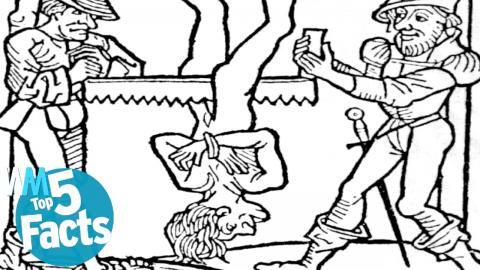Top 5 DISTURBING Medieval Torture Facts

Victim? Check. Sadist on a power trip? Check. Terrifying apparatus designed to mutilate? Check! Looks like we've got everything we need… let's get this unpleasant party started. Welcome to WatchMojo's Top 5 Facts.
Watch on Our YouTube Channel.
In today's instalment, we're counting down the top five seriously twisted facts about medieval torture. Medieval torture practices have been grossly exaggerated over the years, but even when you strip away the myths and get down to the bare bones of it, the real facts are no less grisly or horrifying.
- Written by Michael Wynands
- Top 5 Medieval Torture Facts
- Beheading Was A Rare Privilege
- Torture Was Really A Private Affair Until The Inquisition
- Torture Was Intended to Break the Body & Save the Soul
- Torture Was A Method of Converting Pagans
- The Middle Ages Had A Thing For Penetrative Torture & Genital Mutilation
Top 5 Medieval Torture Facts
Victim? Check. Sadist on a power trip? Check. Terrifying apparatus designed to mutilate? Check! Looks like we’ve got everything we need… let’s get this unpleasant party started. Welcome to WatchMojo’s Top 5 Facts.
In today’s instalment, we’re counting down the top five seriously twisted facts about medieval torture. Medieval torture practices have been grossly exaggerated over the years, but even when you strip away the myths and get down to the bare bones of it, the real facts are no less grisly or horrifying.
#5: Beheading Was A Rare Privilege
Torture was employed in Medieval times for a variety of reasons– as a non-fatal punishment, as a means of extracting a confession and as a method of execution befitting the alleged crime. While popular media makes it look like beheadings took place in the public square every afternoon, in the real world, they were rare occurrences. A beheading sure sounds like a grisly way to go by modern standards, but back in the day, it was considered a mercy - a quick painless death, typically reserved for nobility. For the lower class, they were lucky to be hung… if not, they could be drawn and quartered, subjected to the breaking wheel or other such creative methods of execution.
#4: Torture Was Really A Private Affair Until The Inquisition
A series of inquisitions were carried out in the 12th and 13th centuries, intended to root out and punish heretics who went against church doctrine. But torture wasn’t OFFICIALLY church-sanctioned until the “Ad Extirpanda” papal bull, issued by Pope Innocent IV in 1252 - which permitted it as a means of obtaining confessions in trial. Before that, torture was really an unregulated act of local justice - thieves would have their hands cut off, sex offenders would undergo genital mutilation, yadda yadda. But with church sanctioned-torture, came rules. For example, you could only torture someone once. Also, torture wasn't supposed to involve mutilation or result in death. They employed methods like stretching a body on the rack or searing the flesh with hot metal. You know... “reasonable” torture.
#3: Torture Was Intended to Break the Body & Save the Soul
Torture might look like a simple act of sadism, but it was believed to serve a much higher purpose. Medieval Christianity viewed the human body as a vessel for the soul. The focus was on the afterlife, meaning that one’s corporeal self was of little consequence. Torture was seen as a means of purifying the body, atoning for the earthly sins through the destruction of the physical self, so that the soul might be redeemed. Believe it or not, torturers believed they were helping their victims. Historical German serial killer and black magic practitioner Peter Nirsch famously killed over 500 people and... liked to cut babies out of pregnant mothers. So, his eventual torture involved lacerations, hot oil, and being tied to the rack. The more sinful the life, the more torture a body required.
#2: Torture Was A Method of Converting Pagans
Convert or die. If a confession can be obtained under duress, why not a conversion to the Christian faith? In the early Medieval Era, Saxons who practiced paganism were forced to convert under the rule of Charlemagne. He would conquer, force conversion and sentence any who resisted to death. In the 10th century, Norwegian Kings Harald Greyhide and Olaf I made it a personal mission to convert the country to Christianity. In addition to outlawing other religions and ordering the destruction of all pagan temples, anyone who refused to adopt the new religion would be submitted to torture until they accepted the faith. If they held out, they would be killed. According to the logic of the time, they were being “saved” either way.
#1: The Middle Ages Had A Thing For Penetrative Torture & Genital Mutilation
Bad news torture enthusiasts - the iron maiden was never actually used. Although it certainly looks medieval, it was invented in the 19th century by a man who collected torture devices. But fear not, there’s still plenty of torture devices that were all too real - like the strappado, the rack and something called “rat torture.” The worst techniques however, seemed to target the more… sensitive body parts. The donkey, the Judas Cradle, the saw, and impaling were all torture devices and techniques that brought the anus, vagina or penis in contact with extremely sharp objects. And they just... kept... pushing. It's hard to imagine why anyone would feel the need to retroactively invent faux medieval torture devices when techniques this grotesque already existed.


 0
0
 0
0
 report
report